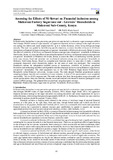Assessing the Effects of M-Shwari on Financial Inclusion among Muhoroni Factory Sugarcane out - Growers’ Households in Muhoroni Sub-County, Kenya
Abstract
In Kenya today the decline in cane production per given unit area has led to a domestic sugar consumption deficit
that averages 200,000 tonnes of sugar annually. An aggressive financial inclusion strategy in the sugar sub-sector
can sealing this deficit and create employment for up to 6 million Kenyans, whilst saving foreign exchange
annually. The study was guided by the following specific objectives; to assess the effect of access to M-Shwari
transactions on financial inclusion among cane out-growers’ households in Muhoroni sub-county, Kenya. to assess
the effect of suitability of M-Shwari on financial inclusion amongst cane out-growers’ households in Muhoroni
Sub-County, Kenya. to assess the effects of procedural formality of M-Shwari on financial inclusion amongst cane
out-growers’ households in Muhoroni sub-county, Kenya, to assess the effects of moderating variable; poverty
level, cane income, fiscal and monetary mix on financial inclusion among cane out-growers’ households in
Muhoroni Sub-County, Kenya. Based on comprehensive literature review on same area of study, a suitable
conceptual framework which dramatically depicts the key areas of study was developed. This conceptual
framework outlines the independent variables (access to transactions, suitability of m-shwari, procedural
formalities and moderating variables) and dependent variables (financial inclusion among Muhoroni sugar factory
out-growers’; households). The study population was all the 5,000 Muhoroni Sugar factory Out-Growers’
Households within Muhoroni sub-county, Kisumu county. The study adopted Stratified proportionate random
sampling technique that allowed construction of error estimates. A total of 366 questionnaires were completed
successfully. This is a 98.9% response rate. The study collected data from the respondent using open-ended and
closed questionnaires. Data was collected, cleaned, coded and analysed with the aid of statistical package for social
sciences (SPSS) package. The gathered data was analysed using descriptive statistics
Collections
- Journal Articles (BE) [405]

